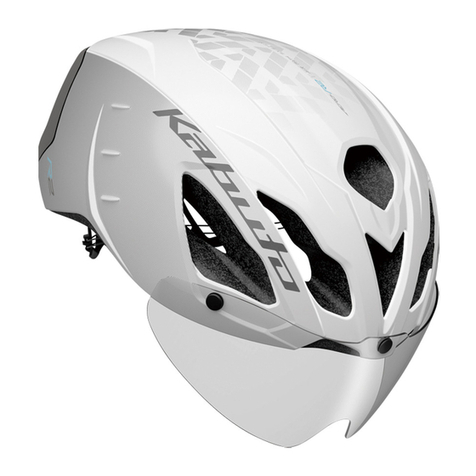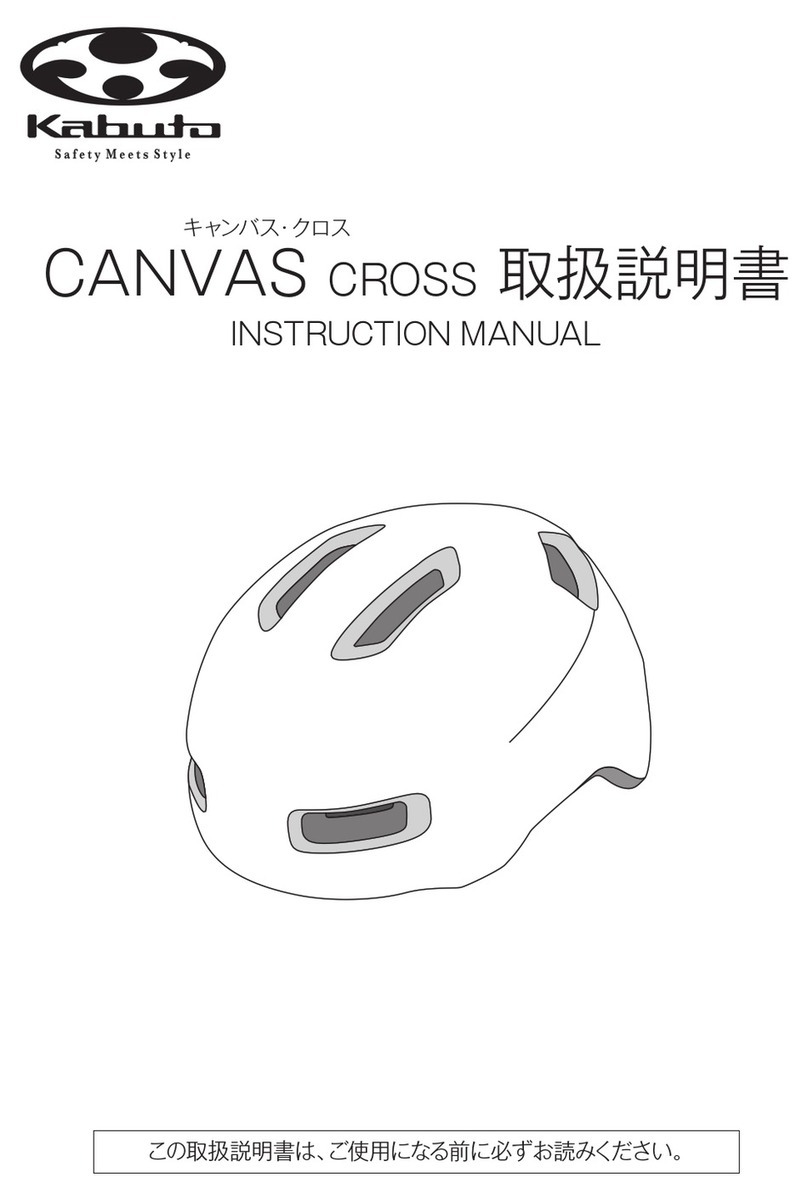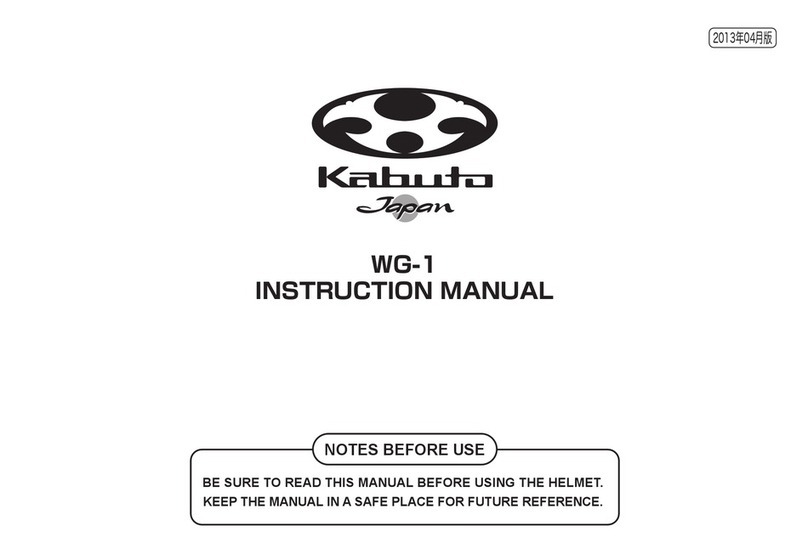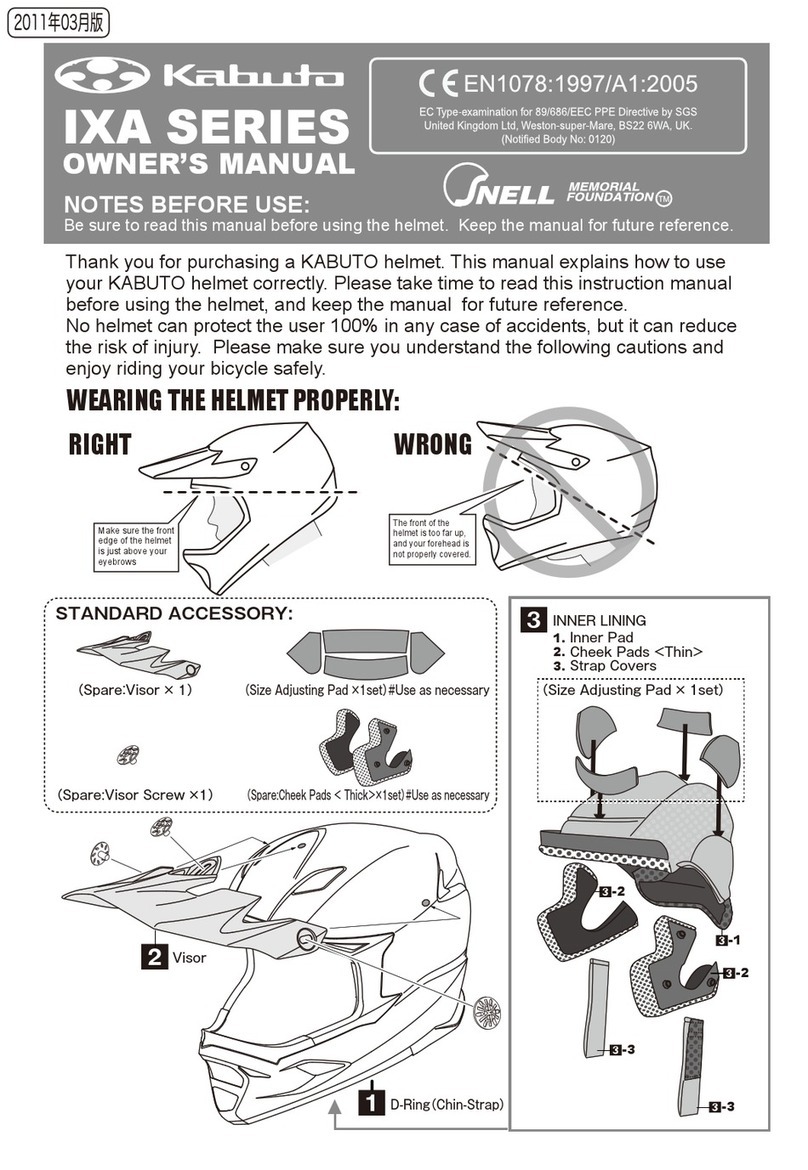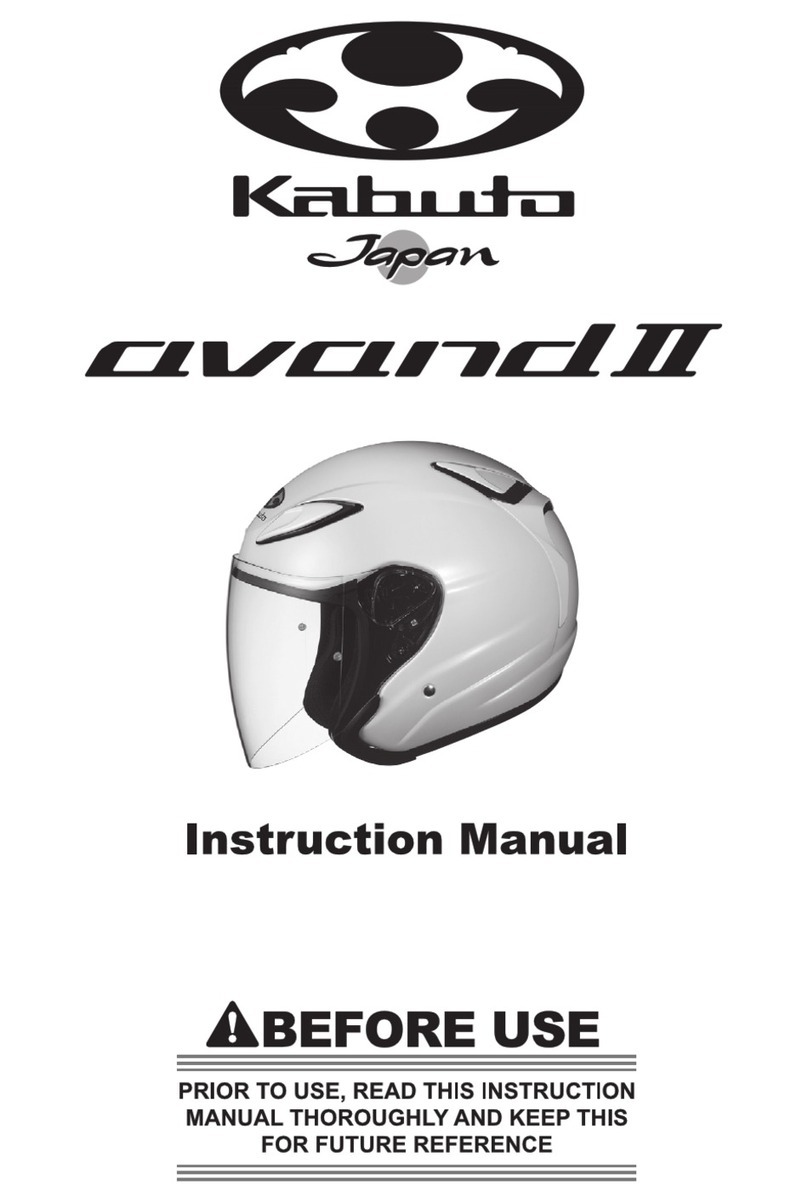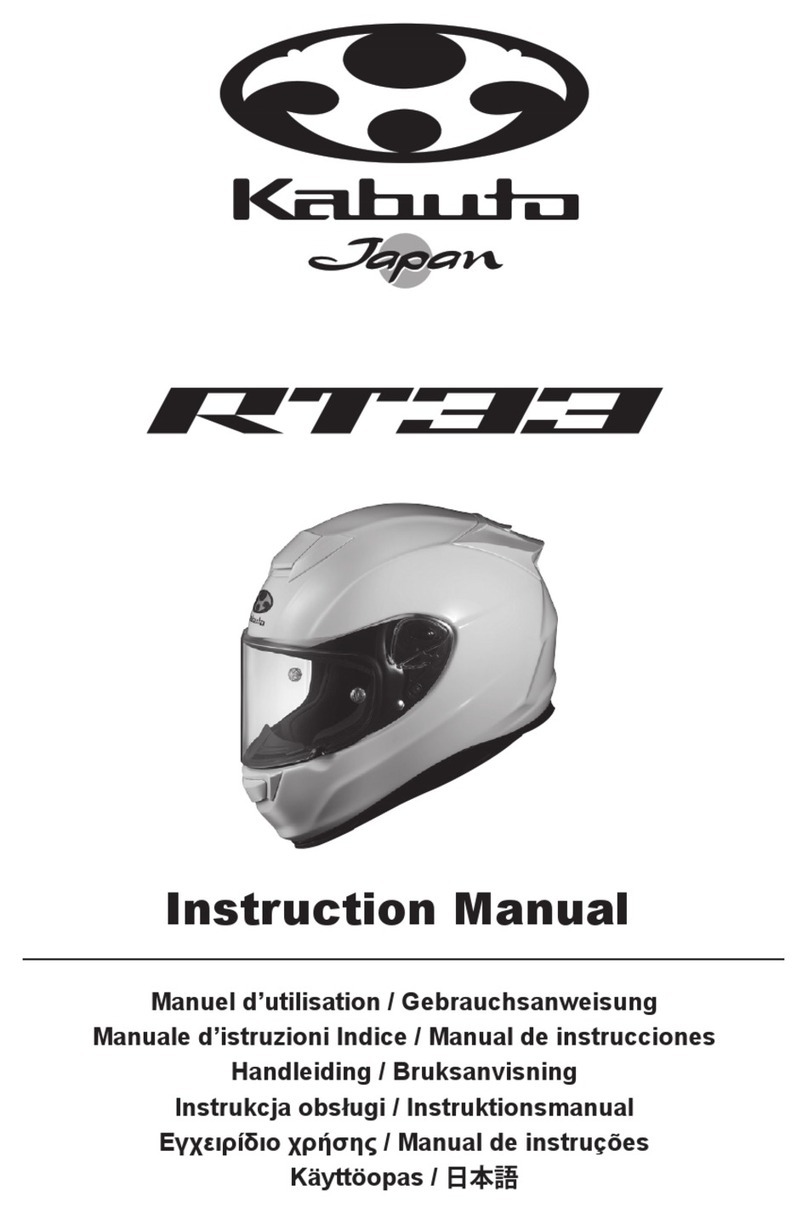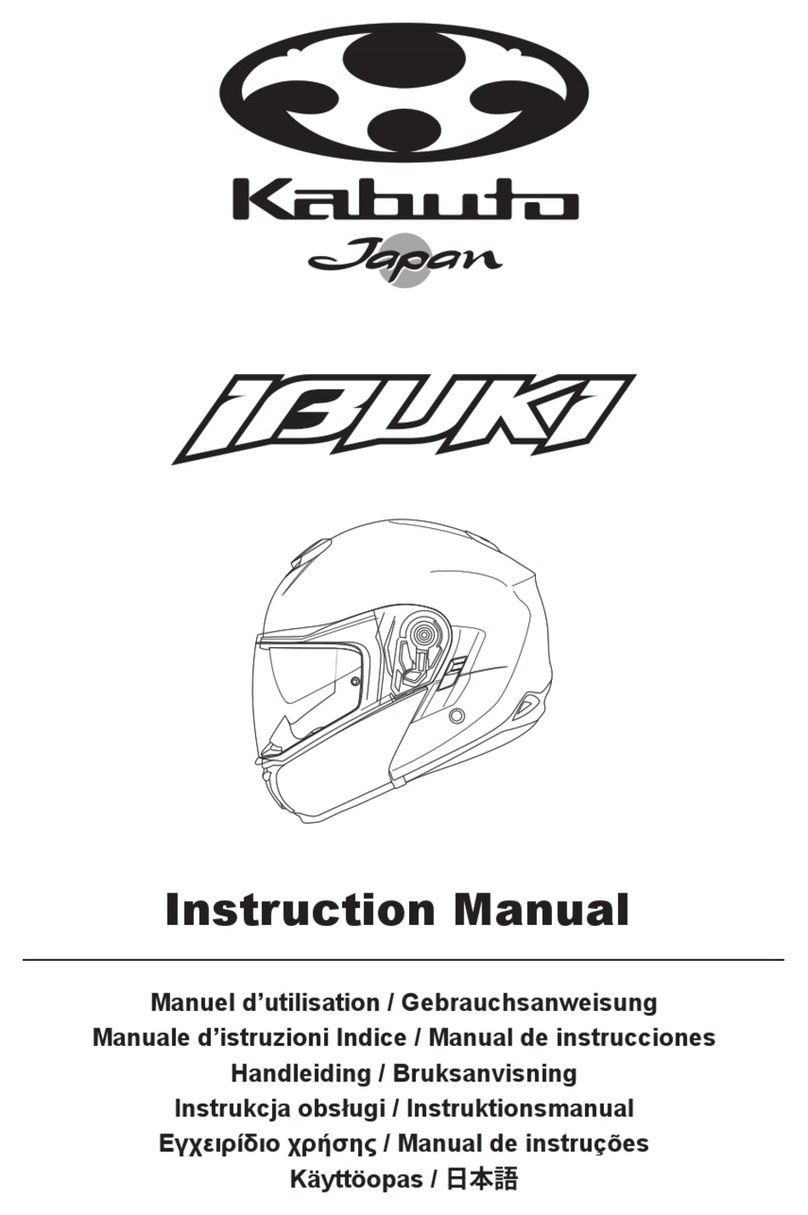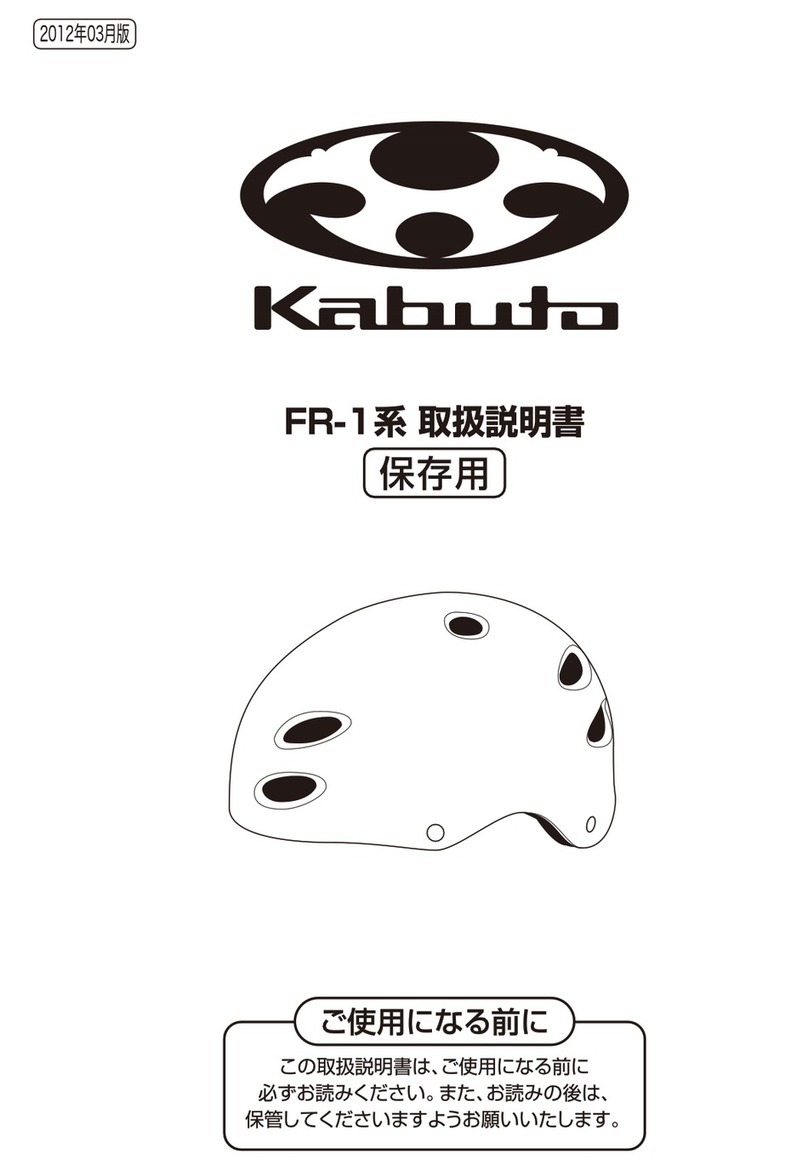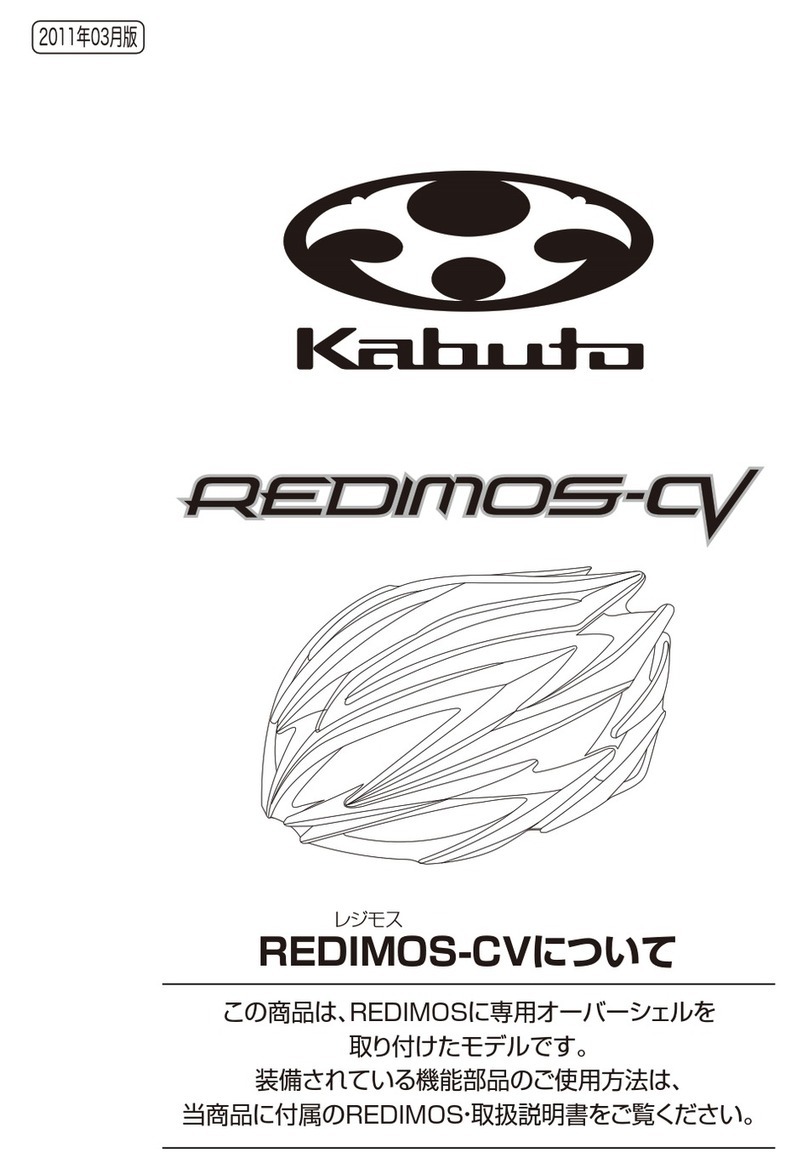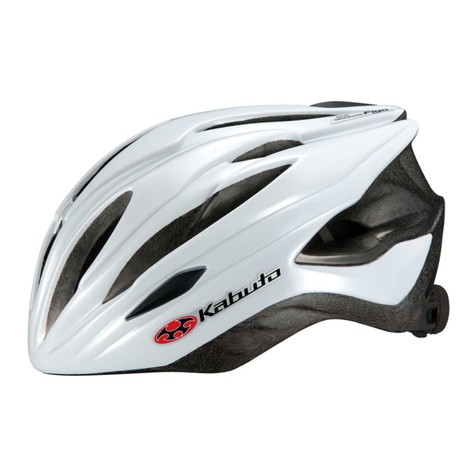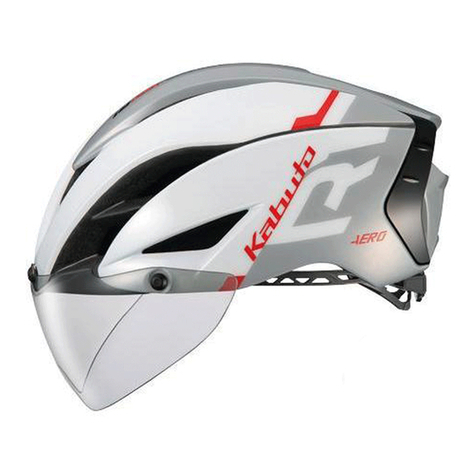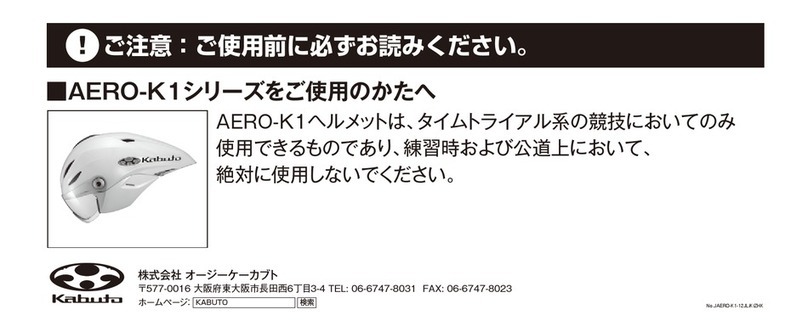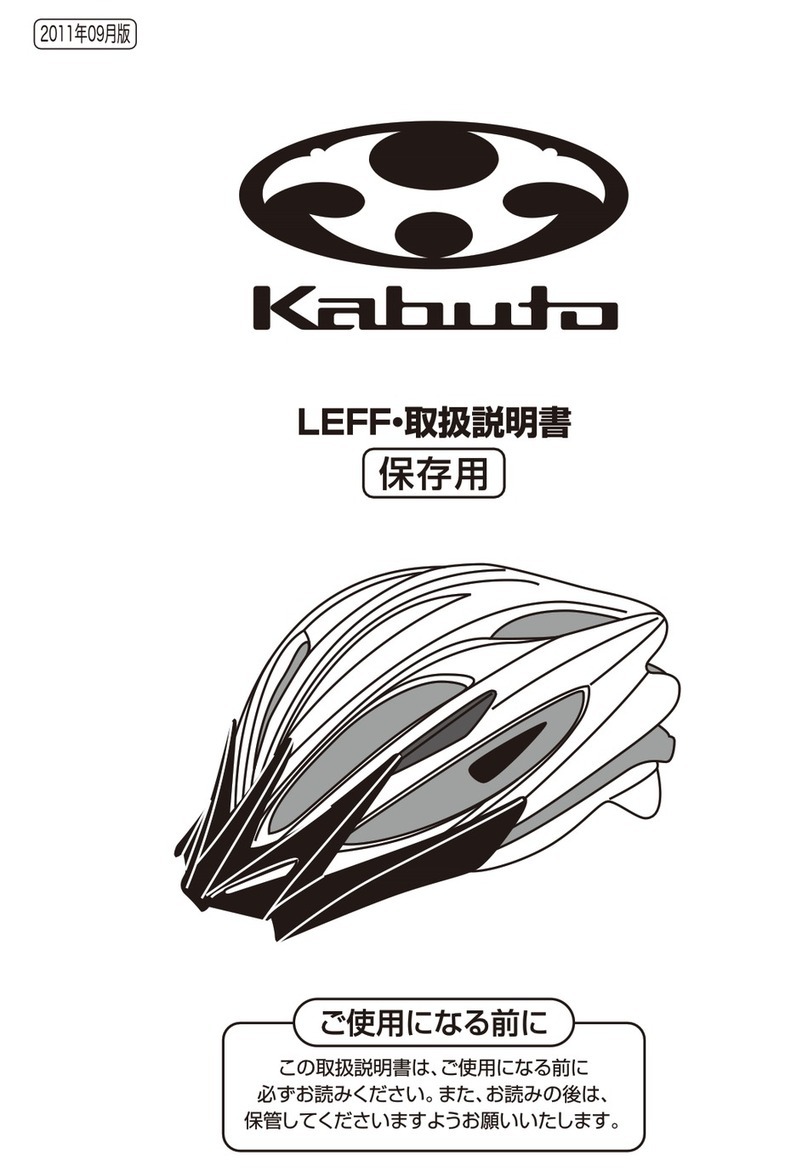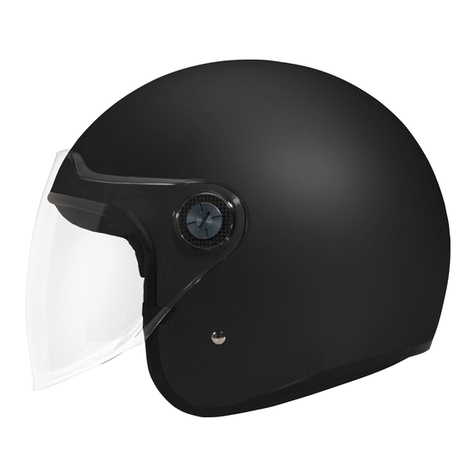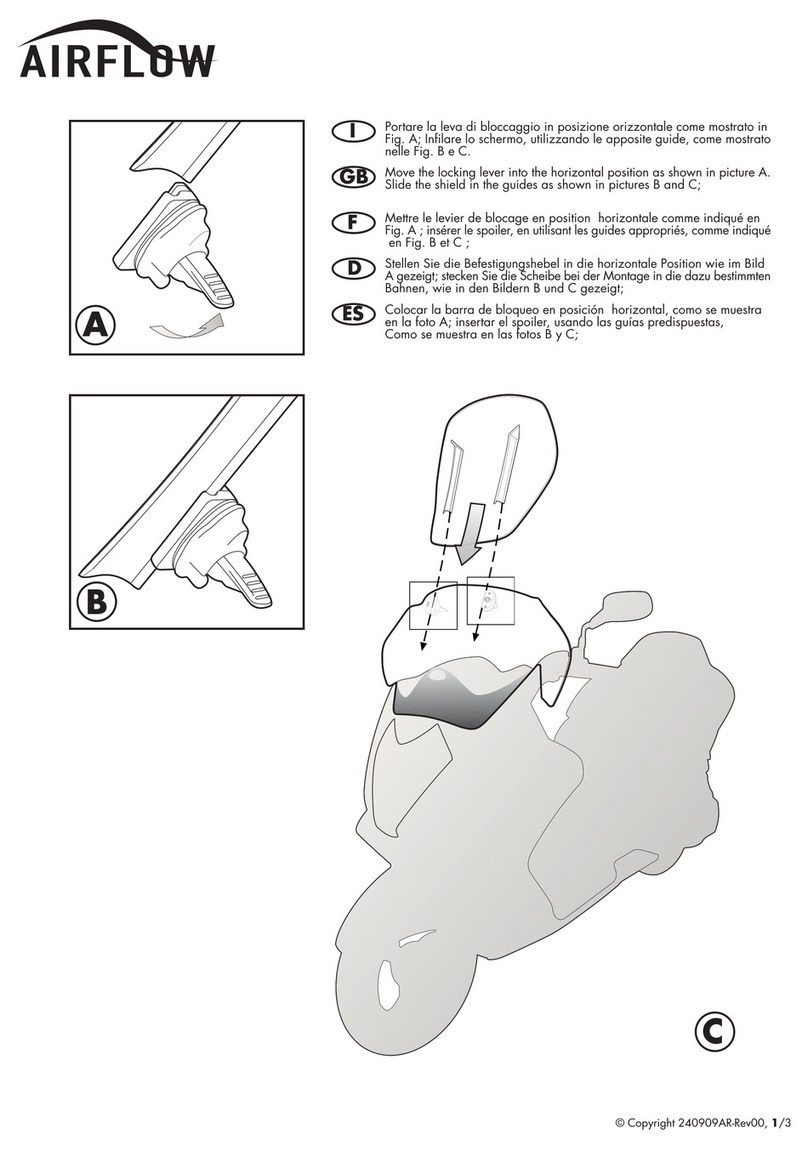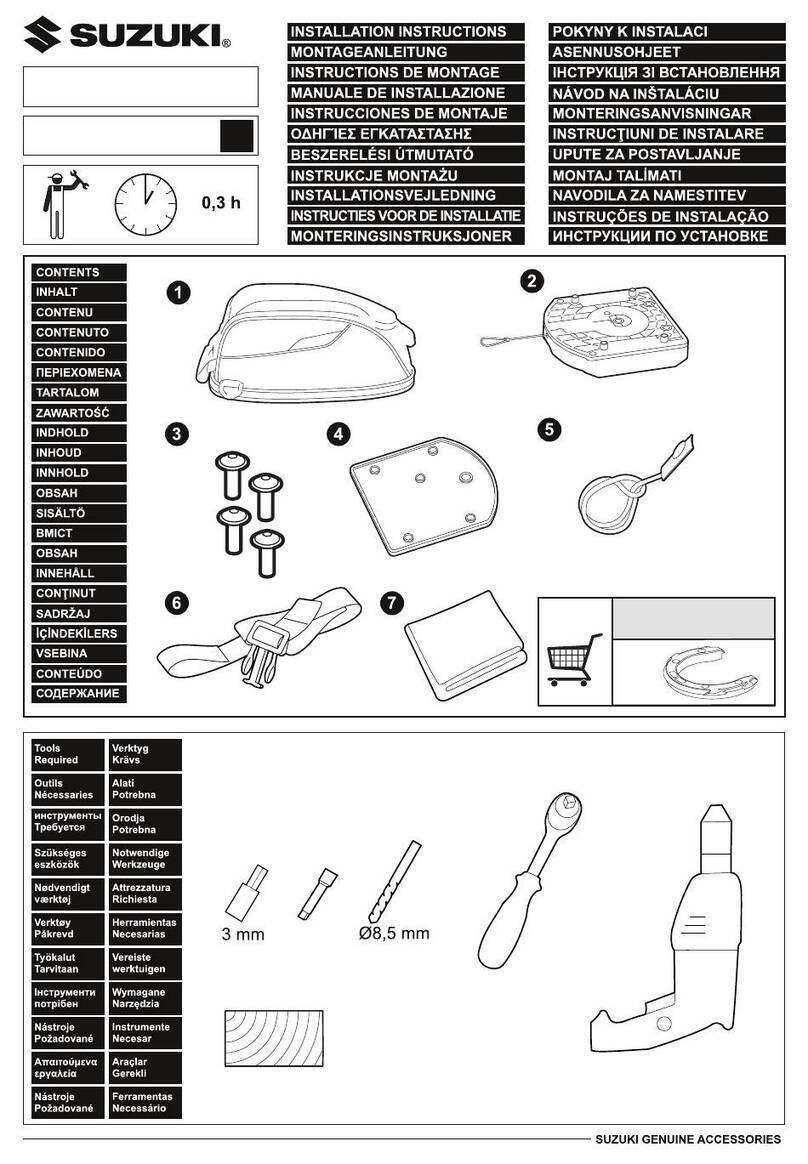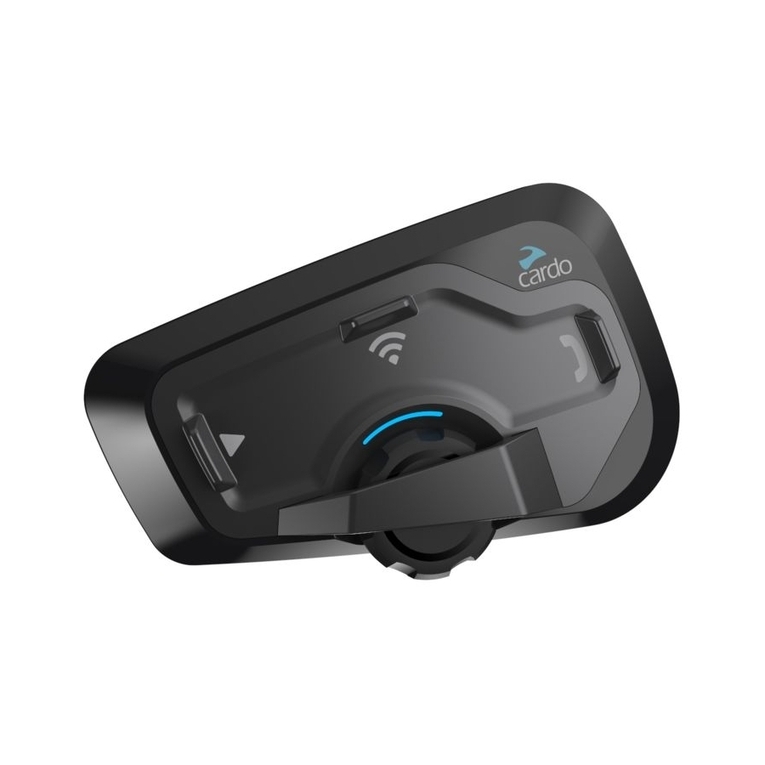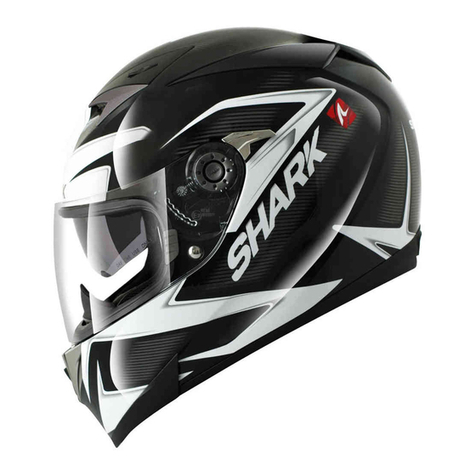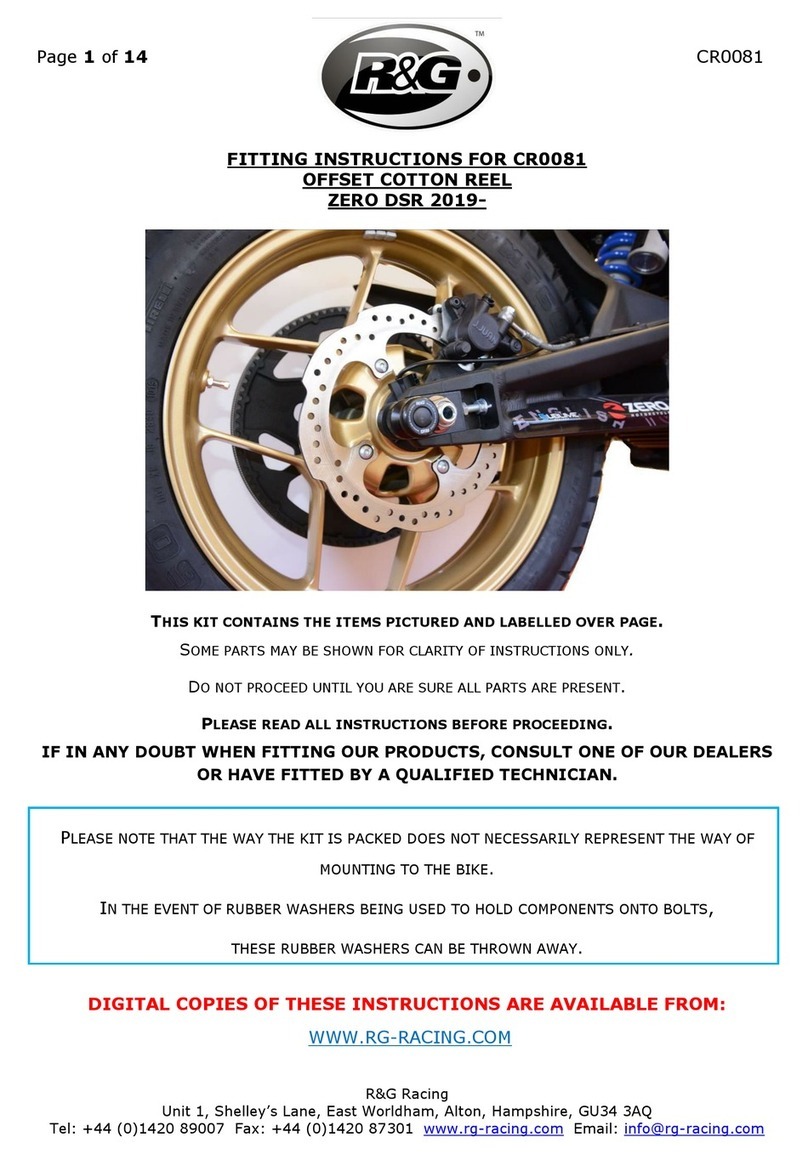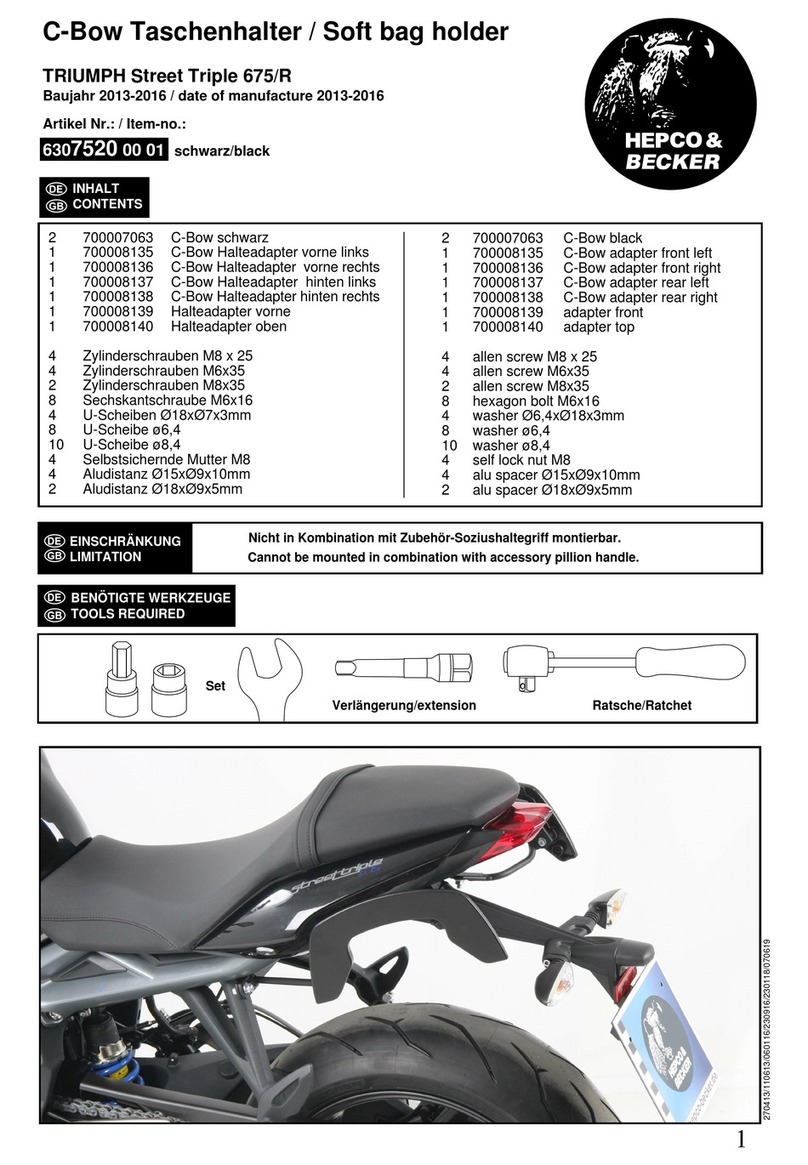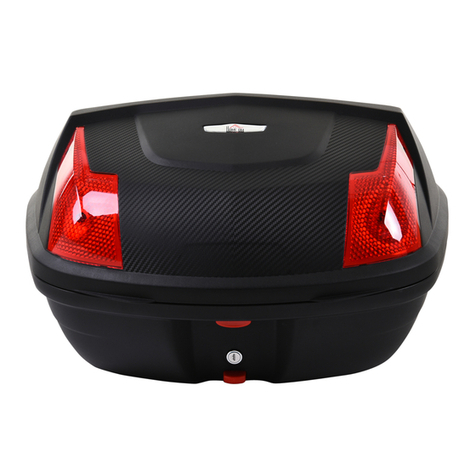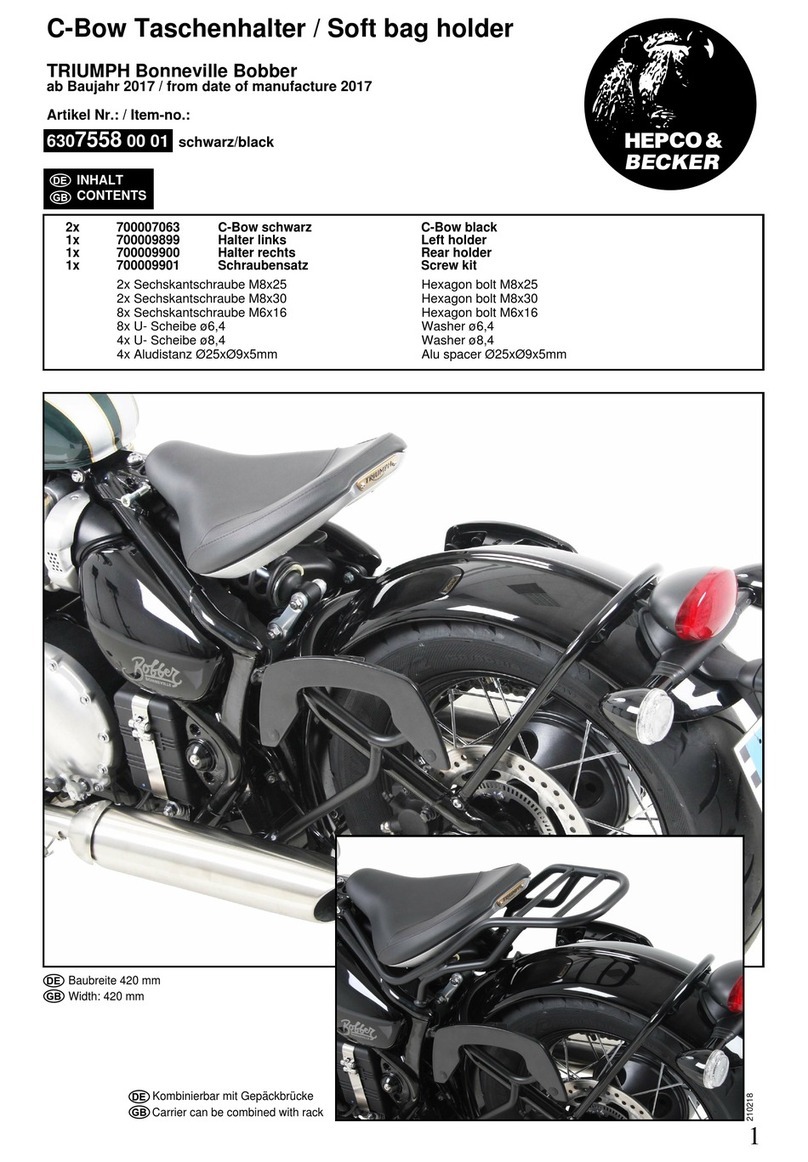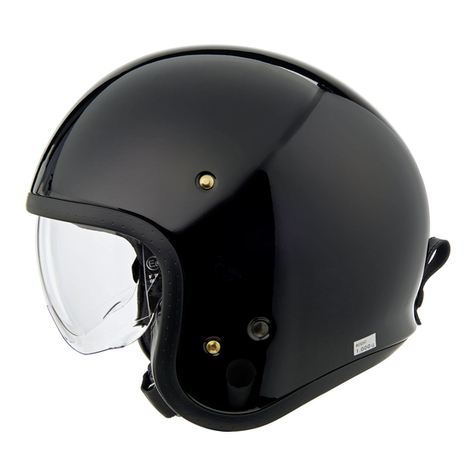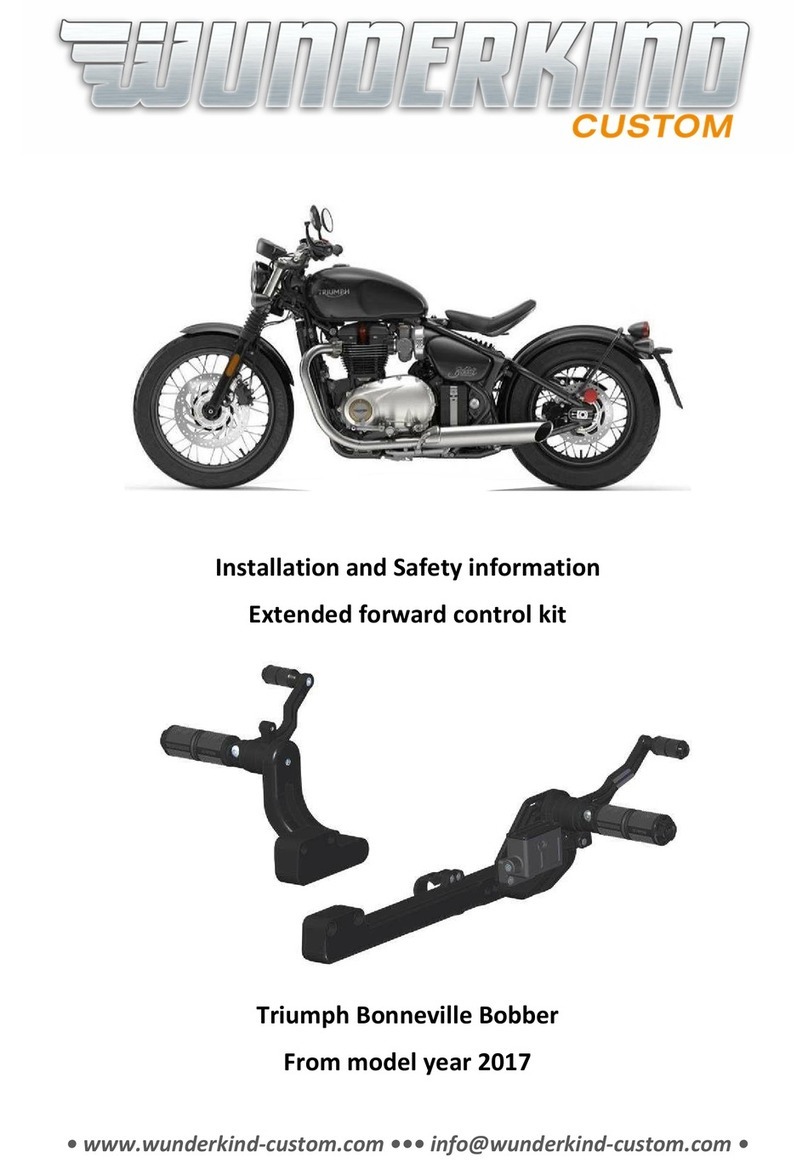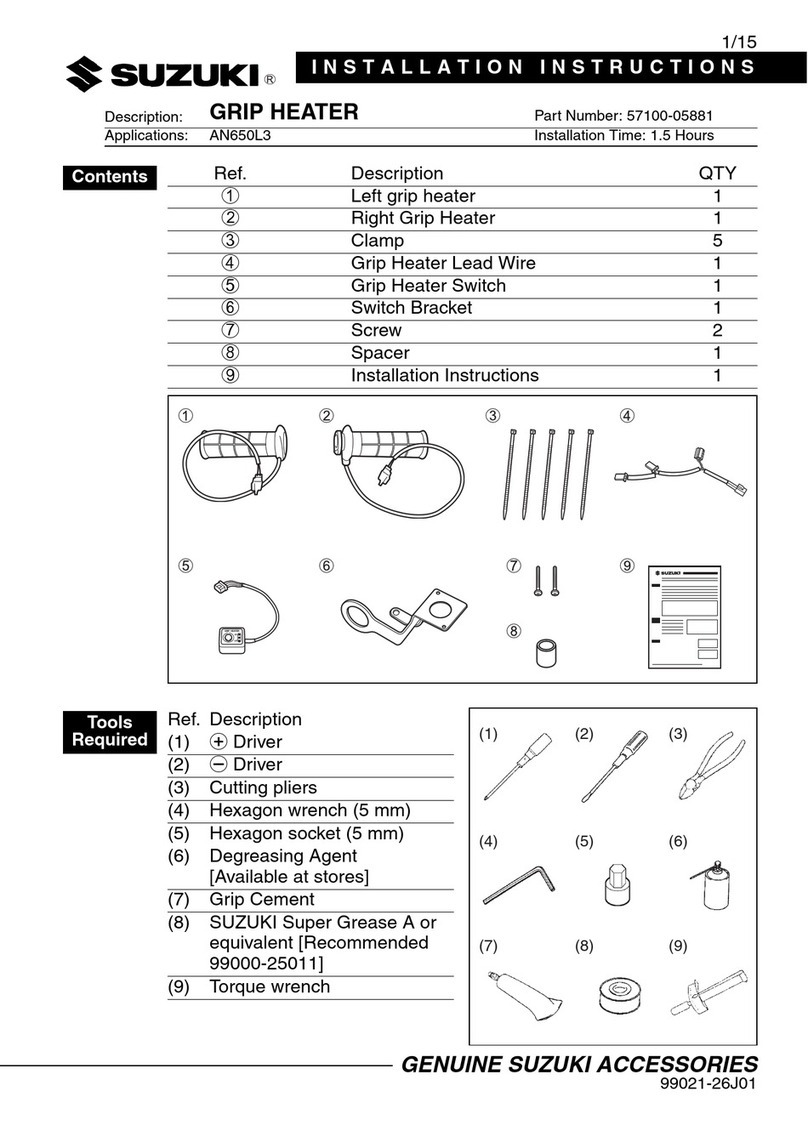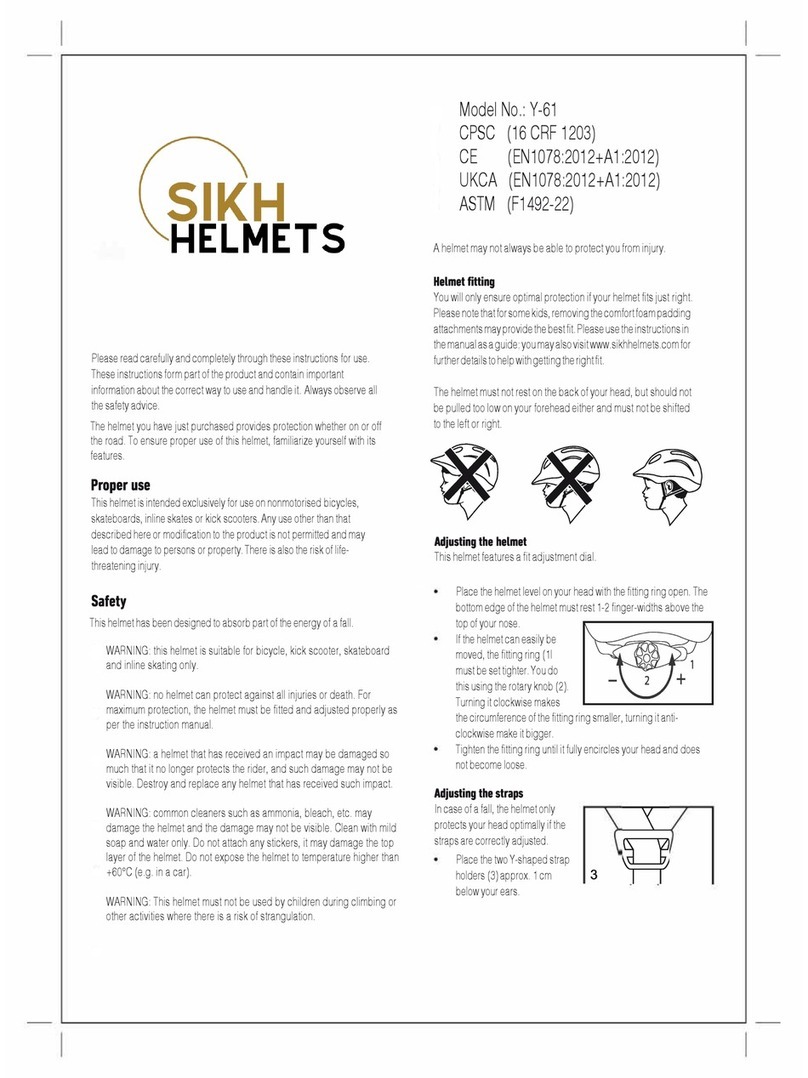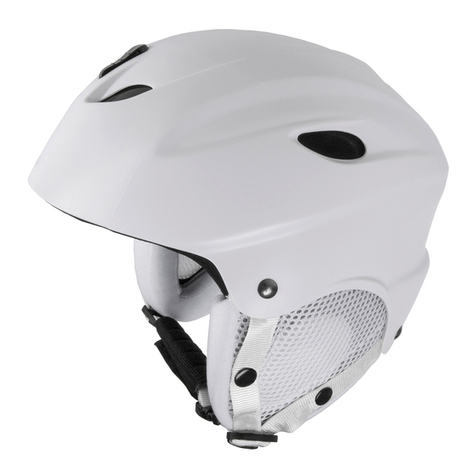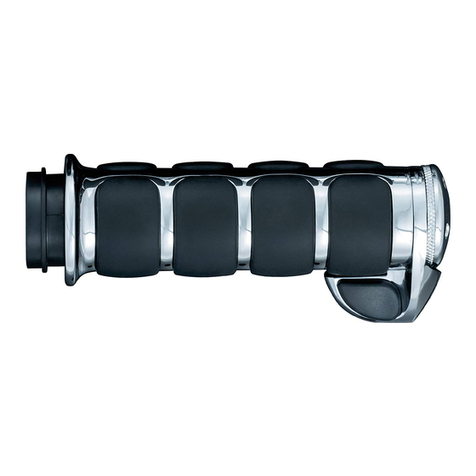1
FF-5V Instruction Manual Table of Contents
NOTES BEFORE USE・・・・・ P-2
FORSAFEANDCOMFORTABLEUSE
1 Remove/Replace Chinstrap Covers・・・・・ P-4
2 Fastening Chinstraps・・・・・ P-5
CHINSTRAPS
3 Open/Close Chin Ventilation・・・・・ P-5
4 "Top Aero-Ventilation System"and"Wake StabilizerPAT.P."・・・・・ P-6
5 Ventilation Shutter Function・・・・・ P-7
AIR-CONDITIONINGFUNCTIONOFVENTILATIONS
6 Single Action Shield SystemPAT.P.・・・・・ P-8
7 Pinlock® Original Insert Lens・・・・・ P-10
8 Remove/Replace Shield Ratchets・・・・・ P-12
SHIELD
IMPORTANT
NOTE
NOTE
9 Remove/Replace Cheek Pads (Cheek Area)・・・・・ P-14
a0Remove/Replace Cheek Pad Inner Foam・・・・・ P-16
Cleaning of Inner Pad and Cheek Pads・・・・・ P-17
Exchangeable Inner Pad and Cheek Pads・・・・・ P-18
aa Remove/Replace Inner Pad・・・・・ P-18
INTERIOR(INNERPADANDCHEEKPADS)
as Remove/Replace Wind Shutter・・・・・ P-20
ad Remove/Replace Breath Guard・・・・・ P-21
"Breath Guard Pro (Optional Accessory)"・・・・・ P-21
STANDARDACCESSORIES
●
FF-5V Series Parts List and Table for Replacement
・・・・・ P-22, P-23
Contact for inquiries and request for repair・・・・・ P-24
FF-5V Instruction Manual Table of Contents
・・・・・ P-1
PARTSLIST
2 3
WARNING
Never operate the shutter lever while riding because it is very hazardous.
Operate the shutter lever before riding.
CAUTION
The ventilation is secured with a
strong adhesive tape. If you attempt
to remove the ventilation by force, a
part may be damaged.
Do not try to remove the ventilation.
Slide the lever to the left, and the shutter is
closed to shut off air intake.
Slide the lever to the right, and the shutter
is opened to take in air.
3
Lever
Chin Ventilation
Slide the lever to the right
Slide the lever to the left
To open
To close
To open
To close
4 5
Open/Close of
Chin Ventilation
CAUTION
The Top Aero-Ventilation and the Wake StabilizerPATENTED are sophisticatedly
designed to achieve light-weight and minimize damage on your head in case
of an accident. A strong impact on the Top Aero-Ventilation and the Wake
StabilizerPATENTED. may damage them. Handle them with care.
4
Top Aero-Ventilation System
Outer air
Humid air
Liner
Shell
Humid air inside of the helmet
Top ventilation
Outer air
Outer air
Liner Shell
Head-Ventilation
The Wake StabilizerPATENTED , KABUTO’s unique
system, is developed by analyzing the results of
wind tunnel experiments at several angles. This
unique system controls the airflow around the
helmet and reduces loads while riding.
Wake StabilizerPATENTED
The Top Aero-Ventilation is
equipped with individual shutters in
the front, rear, right and left sides,
which can open and close in three
levels according to situations and
preferences of the user.
5Ventilation Shutter Function
Slide the lever forwards to shut off air from
the outside.
Slide the lever backwards to introduce
air from the outside.
Slide the lever of the Top Aero-Ventilation backwards,
and the shutter of the air duct is opened to discharge
the inside humid air forcibly.
Slide the lever of the Top Aero-Ventilation forwards,
and the shutter of the air duct is closed to stop forcing
out the inside humid air.
Lever
Air duct
Lever
Slide the lever forwards
CAUTION
Each ventilation is secured with a strong adhesive tape. If you attempt to
remove the ventilation system by force, a part may be damaged. Therefore, do
not try to remove the ventilation system.
To open
To close
To open
Lever
Slide the lever backwards
Slide the lever backwards
To close
Lever
To open
To close
To open
To close
6 7
A helmet is pulled backwards due to the
air pressure from ahead while riding.
However, the Top-Aero-Ventilation
System helps resolving such matter.
The Top Aero-Ventilation System
improves the air-flow effectively, and
discharges humid air inside of the helmet
to the outside by the “negative pressure”.
As a result, the inside of the helmet is
comfortable in hot summer and under
hard conditions such as racing scenes.
The Top Aero-Ventilation
System is equipped with a
shutter function to allow
adjustments of air intakes as
desired to shut off cold air in
cold winter and water drops in
rainy weather.
“Top Aero-Ventilation System” and “Wake
StabilizerPATENTED.”
Slide
the lever
forwards
Open/Close
Head Ventilation
Open/Close
Top Aero-Ventilation
Please read “WARNING” and “Repairing the ventilations” on the next page.
Wake Stabilizer PATENTED.
Head-Ventilation
Top Aero-Ventilation
Top Aero-Ventilation System
Top Aero-Ventilation System
Air duct
Air duct
Head-Ventilation
Head-Ventilation
SectionviewofTopAero-VentilationSystem
The “Single Action Shield System PATENTED” is the shield replacement system
developed by KABUTO. The system allows quick shield replacement for riding and
racing conditions and easy maintenance.
6Single Action Shield SystemPAT.P.
WARNING
●Operating the shutter while riding is very dangerous. Never operate the
shutter while riding. Operate it before riding.
●The air-ducts (air intakes and discharge holes) of the head ventilations and the
Top Aero-Ventilation are designed in the proper sizes and quantities
considered a large impact in the event of accidents and falling down.
Customizing by enlarging or making more air-ducts would reduce the safety
performances significantly and can cause serious injuries in case of an
accident. Never customize your helmet.
CAUTION
●The shield is so constructed that it cannot
be removed unless it is moved up to the
highest position.
●Do not pull or twist the shield by force to
remove it. Such action may damage the
shield and ratchet system.
●Handle the removed shield with care in
order not to damage it.
Repairing the ventilations
When each ventilation is damaged, contact your local authorized dealer (See
Pages 23 to 25).
Please be informed that we may not accept repairing, in the case the safety
performance of the helmet will be degraded.
How to remove the shield:
aMove the shield up(Fig. 1). (Move it up as far as it
goes.)
bAs shown in Fig. 2, pull the shield in the direction of
the arrow while pressing down the release button on
the shield. One side of the shield is completely
removed.
*The shield can be removed easily by pulling it along
the angle of the end of release button.
cRepeat the same procedure for removing the other
side of the shield. Then the entire shield can be
completely removed.
Shield
Release button
Move the shield up as far as it goes.
Release button
①Pressing down the button①Pressing down the button
Release button end
Fig.1
Fig.2
CAUTION
●Do not push or twist the shield by force
when installing it. Such action may
damage the shield and ratchet system.
●After the installation of the shield, be sure to pull it lightly towards the
removing direction to make sure that it is securely installed.
●After the installation of the shield is completed, open and close the shield
three to four times to make sure that the shield is properly worked.
How to attach the shield:
aAs shown in AandB, align the angles of the shield
release button and the part Aon the Shield Ratchet,
and set the mechanical part of the shield on the
ratchet as shown in C.
bInsert the shield in the direction of the arrow as far as
it goes, then the shield can be attached. Follow the
same procedure to attach the shield on the other
side. (DThe installation of the shield is complete).
WARNING
●After the installation of the shield, make sure the shield is securely installed
and that it is properly opened and closed before riding. If the shield does not
work properly, or is installed insecurely, it may cause a failure in opening and
closing the shield or lead to the removal of the shield while riding, thereby
causing a great risk. If the opening and closing operations are not properly
performed or abnormal noise is heard during these operations, check the
steps in the installation procedure and repeat the installation procedure from
the start.
●The shield is a consumable item. If the shield surface is damaged by a bug,
stone, etc. hitting on the surface, it may hinder the vision, thereby causing a
great risk. If the shield gets extremely dirty or scratched, replace it with a new
one.
❷❶ ❸
❹
Same angleSame angle
Shield RatchetShield Ratchet
Shield Release button
A
A
Shield
8 9
Pull the shield in the
direction of the arrow
Pull the shield in the
direction of the arrow
Pull it along the
angle of the end of
button
Hook on shield
mechanism
Hook on shield
mechanism
Cover the Shield
Ratchet
Hook of Shield
Ratchet
Hook of Shield
Ratchet
First, stop at this
position
Then insert
the shield in
the direction
of the arrow as
far as it goes
10 11
The “Shield Ratchet” is a part to control the open/close the shield and the function of
the “Single Action Shield SystemPATENTED.” When the shield is completely removed in the
procedure mentioned in 6“Single Action Shield SystemPATENTED.”, the Shield Ratchet
appears.
8
Remove/Replace Shield Ratchets
Shield Ratchet
Shield Ratchet Screw
How to remove the Shield
Ratchet:
Turn the Shield Ratchet Screws on
the Shield Ratchet counterclockwise
using a proper sized flat-blade
screwdriver until the screws are
removed. Then, the shield ratchet
can be removed. Follow the same
procedure to remove the Shield
Ratchet on the other side.
How to install the Shield Ratchet:
Shield Ratchet
bPlace the Shield Ratchet in the hollow
space on the side of the helmet and
align the mounting holes on the shield
ratchet with the mounting holes on the
helmet (Fig. 2).
cFasten both Shield Ratchet Screws
clockwise securely. Repeat the same
procedure on the other Shield Ratchet.
Then the Shield Ratchets are installed
(Fig. 3)
Shield Ratchet Screw
Shield Ratchet
Helmet
CAUTION
●Do not fasten the Shield Ratchet Screws too tight. Too much tightening of the
screws may damage screws and other parts.
●Fasten the Shield Ratchet Screws by applying the screwdriver vertically to the
screws. If the screws are fastened by applying a screwdriver diagonally, the
threads may be stripped.
WARNING
●
The Shield Ratchet is an important part for open/close the shield. Install the
Shield Ratchet securely. After the installation is completed, check to see that the
shield can be closed to the lowest position and opened and closed correctly.
●Check and fasten the Shield Ratchet Screws regularly. Riding with the
loosened Shield Ratchet Screws is very dangerous as the shield may be
removed while riding.
Fig.2 Fig.3
12 13
Proper sized
flat-blade screwdriver
Screw-inserting
hole
Fig.1
Right Left
aFirst, check the side of the Shield
Ratchet as shown in Fig. 1.
Fig.3
Fig.4
9Remove/Replace
of Cheek Pads
Cheek pad Snap
cheek pad
Front
Joint Hook
*Pull the Front Joint Hook to the direction of the arrow.
*Grab the base of the snaps firmly.
CAUTION
When removing the cheek
pads, be sure to grip the
base of cheek pads where
the snaps are attached.
Otherwise, the cheek pads
may be damaged.
Removing the cheek pad:
aFirst, undo the 2 snaps at the
rear side of the cheek pad.
bPull the chinstrap out from the
cheek pad. (Fig.1)
cGrip the base of the middle of
the cheek pad securely, and
pull it. (Fig.2)
d
Pull out the front Joint Hook at the
front of the cheek pad to the
direction of the arrow as shown in
theFig.3.
ePull out the rear Joint Hook by
turning it around the Joint Bar
as shown in Fig.4.
*Refer to “Undoing the Rear
Joint Hook”, below.
Rear joint hook
Undoing the Rear Joint Hook
Attached status
Rear joint hook
Joint bar
Backofthehelmet
Fig.1
Fig.2
Rear joint hook
Rear joint bar
(Between the shell
and the liner)
Attachment of Cheek pads: ATTACHING THE JOINT BAR
Rear joint hook
Joint bar
Push the middle of the cheek pad.
cPush the middle of the cheek pad into
the trim rubber in-between the helmet
shell and the liner.
Front Joint Hook
Flip the trim rubber up
Flip the trim rubber up
Chin liner
Cheek pad
Cheek pad
Snap
CAUTION
Be sure that the cheek pads are attached on the helmet securely before riding.
It is hazardous to use this helmet without cheek pads or attaching the cheek pads improperly.
Fig.1
Fig.2
Fig.3 Fig.4
14 15
Repeat the above steps on the
other side.
Pull the middle of
the cheek pad
toward you.
Turn it to the
direction of
the arrow.
Turn it to the
direction of
the arrow.
Pull it to the direction
of the arrow.
Pull it to the direction
of the arrow.
aa
b
b
Joint bar
(between the shell
and the liner)
aInsert the rear Joint Hook in-between the shell and the liner from the position shown
in the figure, and hook it to the "Joint Bar" hidden inside there.
Attaching is
complete
bFlip up the rubber trim around the chin
area as shown in Fig.2. Insert the front
Joint Hook in-between the helmet shell
and chin liner until the Joint Hook is
fixed.
d
Let the chinstrap go through the chinstrap
cover, then fasten 2 snaps and hook and loop
fasteners at the back side of the cheek pad.
Follow the same procedures on the other side.
Push it into the
direction of the
arrow.
a
Turn it to the
direction of the
arrow.
b
Snaps
and
hook-and loop
fasteners
CAUTION
●Use detergent in cold water or warm water for cleaning. Never use hot water,
chemical detergents, and organic solvents for cleaning the pads. The use of
these agents may degrade the quality and damage the pads.
●The interiors of this helmet are washable by a washing machine. Put each pad
in a washing net and wash them separately.
●The cheek pads are consumable items. Even under normal usage, the fabric
material and inner foam may be worn and deteriorated depending on the
frequency of usage. Please replace the pads with new ones as appropriate.
10
Remove/Replace Cheek Pad Inner Foam
Plastic base
Lock-
cloth
Hook-and-
loop
fastener
Hook-and-loop
fasteners
Inner form
–Left– –Right–
Inner form
*Pay attention to the side Plastic base
How to replace Cheek Pad inner Foam:
aReplace the Inner Foam
properly by checking the side of
the Cheek Pad Inner Foam.
(Fig.1)
bInsert the plastic base into the
hole of the base plate on the
cheek pad as shown Fig.2.
Fig.1
Fig.2 Fig.3
①
Fig.1
①
Fig.2
②
② ③
CAUTION
●Attaching the wrong side of the inner foam into the cheek pad may cause a
significant deterioration of fitting.
●Be sure to attach the correct side of the inner foam.
CAUTION
●The interiors of this helmet are washable by a washing machine. Put each pad
in a washing net and wash them separately.
●Use detergent in cold water or warm water for cleaning. Never use hot water,
chemical detergents, and organic solvents for cleaning the pads. The use of
these agents may degrade the quality and damage the pads.
●Even commercially-available detergent may cause a little discolouration of the
pad depending on the type of detergent. Thus, wash each pad separately as
much as practical.
●If the pad is washed in a washing machine having a drying function in which the
temperature is increased to 50or more, it may cause deterioration in quality
and damage of the pads. Do not use such a device for cleaning of the pad.
● Drain a pad after washing and dry the pad in shade so that it is not exposed to
direct sunlight. After making sure that it is dried enough, attach it on the helmet.
●The inner pad and the cheek pad are consumable items. Even under normal
usage, the fabric material and inner foam may be worn and deteriorated
depending on the frequency of usage. Please replace the pads with new ones as
appropriate.
Lock-Cloth
Hole for chinstrap
Interlining back of a cheek pad
Fig.3
③
16 17
Cleaning of Inner Pad, Cheek Pads and Chinstrap covers
IMPORTANT
cLet the “Lock-cloth” go through the cheek pad from the front then fasten the hook
and loop fasteners on the back.
a
Remove the “Lock-cloth” at the back side of the
cheek pad from the hook and loop fasteners. (Fig.1)
bTake out the plastic base at the back side of the
cheek pad as shown in Fig.2.
cTake out the inner form.
Take out the inner foam for washing when it
gets dirty.
CAUTION
Do not pull the interlining and snaps by
force when removing the inner pad.
Otherwise, the fabrics of those pads
may be damaged.
FF-5V interiors are exchangeable as shown in the table below. Fine fitting can be
achieved by changing only cheek pads etc.
Exchangeable Inner Pad, Cheek Pads and Chinstrap covers
11
How to remove the inner pad:
aHold the helmet as shown in Fig.1 and then
remove the interlining at the temple area on
the right and left, individually.
bRemove the interlining at the center as
shown in Fig.2.
cUnfasten the 3 snaps on the back of the
rear to remove the inner pad completely.
Inner
pad
■FF-5V Inner pad
Exchangeable
Included in package
Inner pad ×1pce
Inner pad ×1pce
Inner pad ×1pce
Pad size (Thickness)
XS (19mm)
S (15mm)
M (15mm)
L (9mm)
XL (9mm)
XXL (6mm)
Shell size
S
L
XL
■FF-5V Cheek pads
*FF-5V chinstrap covers are exchangeable for all sizes.
Exchangeable Included in package
Pad size (Thickness)
S (37mm)
S (33mm)
M (29mm)
L (24mm)
XL (24mm)
XXL (20mm)
Shell size
S
L
XL
Fig.1
Fig.2
CAUTION
●If the inner pad is not securely installed, the helmet may be unstable while
riding, thereby causing a great risk. Fasten the snaps properly.
●It is also important to attach the pads properly to wear your helmet
comfortably.
How to attach the inner pad:
aInsert the joint hook at the
centre of the inner pad into
the attachment slit on the
helmet as shown in
Fig.1.△is the guideline for
attachment.
bInsert the interlining and
the joint hooks carefully
into the attachment slits
from the centre to the side,
as shown in Fig.2. Follow
the same procedure on the
other side.
cFasten 3 snaps at the rear
to attach the inner pad
completely.
Fitting slit △is the guideline.
Joint hook
Joint hook
Interlining
Attachment slitAttachment slit
Fig.1
Fig.2
18 19
NOTE
Exchangeable between
two sizes of
M and L
Exchangeable between
two sizes of
XS and S
Exchangeable between
two sizes of XL and XXL
Exchangeable among
all sizes Cheek Pad ×1 set
(Right and Left)
Remove/Replace Inner Pad
Inner
pad
Insert the interlining
carefully into the
individual
attachment slit.
Insert the interlining under the rubber trim with care especially,in
this area.
CAUTION
●Install the Wind Shutter-2 securely. Insecure
installation may cause falling of the Wind
Shutter-2 while riding.
●Do not use an adhesive agent or similar items but
install the Wind Shutter-2 according to the
procedure given above. Some components of an
adhesive agent may damage the material of the
helmet.
12
Remove/Replace Wind Shutter-2
How to install Wind Shutter:
aRefer to Fig.1 and check the front side
and back side of the Wind Shutter-2.
bAs shown in Fig. 2, turn the helmet
over and attach the Wind Shutter-2 on
the front (chin area) of the helmet.
In doing this, insert the interlining of
both sides of the Wind Shutter-2
in-between the front area of the cheek
pad and the rubber trim.
cAs shown in Fig. 3, insert the interlining
of the Wind Shutter-2 uniformly into the
inside of the rubber trim from both
sides towards the centre.
dPut the interlining to such an extent
that the edge of the frame rubber is
almost flat with the Wind Shutter-2.
The attachment of the Wind Shutter-2
is complete (Fig.4).
The Wind Shutter-2 is included in the package as a standard accessory. This
accessory is intended to reduce the introduction of wind from chin area while riding. It
can be attached and detached as desired according to seasons and intended
applications.
Front Back
Wind Shutter-2
Interlining
Wind Shutter-2
Cheek pad
ネックパッド
Cheek pad
Rubber trim
(Front)
Rubber trim
(Front)
Rubber trim
(Front)
Insert in-between.
Insert in-between.
Insert in-between.
Installation is complete.
Wind Shutter-2
Wind Shutter-2
Fig.1
Fig.3
Fig.4
Fig.2
How to remove Wind Shutter-2
Firmly hold the interlining area around
the centre of the Wind Shutter-2 and pull
it up. Then the Wind Shutter-2 will be
removed.
CAUTION
To remove the Wind Shutter-2, gently
pull up and take off carefully.
Otherwise the cloth and/or part may
be damaged.
13
Remove/Replace Breath Guard
The "Breath Guard" can be detached or
attached according to your needs.
DETACHING:
Grip the Breath Guard securely, and pull
it out to remove it.
ATTACHING:
As shown in the figure, set the centre of
the Breath Guard onto the centre of the
helmet, and push in the Breath Guard
between the shield rubber trim and the
chin liner.
Chin liner
Breath Guard
Centre of helmet
Breath Guard
CAUTION
Do not use an adhesive agent but
follow the procedure given above to
attach the Breath Guard.
Some components of an adhesive
agent may damage the material of
the helmet.
In addition to this standard Breath Guard, Breath Guard Pro, a larger size
than Breath Guard, is available as an optional accessory. Breath Guard Pro
is available at authorized dealers of KABUTO helmets.
①
② ③
④
20 21
Stitching side is back
Put the interlining into the inside of the rubber trim
from both sides towards the center by hands.
Put the interlining to such an extent that the
edge of the frame rubber is almost flat with the
Wind Shutter-2.
Hold the interlining
around the centre
and pull it up.
Wind Shutter-2Wind Shutter-2
Insert
in-between
Shield frame
rubber
Shield rubber
trim
Breath Guard Pro (Optional accessory)
NOTE
CAUTION
●The following parts cannot be repaired to assure the
performance of the helmet.
•Helmet body (Shell) •Shock absorbing liner
•Chinstraps including D rings
●Contact the authorized KABUTO dealers for detailed
information on repairing.
●FF-5V Series Parts List and Table for Replacement
FF-5V Series Parts for Repair
FF-5V Series Parts for Replacement
A
B
Top Aero Ventilation and
Wake Stabilizer
Wake Stabilizer
Head Ventilation
C
D
Chin Ventilation
Singlecolour
Graphics
Singlecolour
Graphics
Singlecolour
ForSsizeshell(Ssize)
ForLsizeshell(MsizeandLsize)
ForXLsizeshell(XLandXXLsize)
●Exclusive to FF-5V
●When the Top Aero-Ventilation is replaced, both sides
of the Wake Stabilizer need to be replaced together.
● Exclusive to FF-5V
● The Head ventilation on the right and left will be
replaced together.
● Exclusive to FF-5V
● Both sides of the Wake Stabilizer will be replaced
together.
●Part’s size will be different according to the shell size.
●Exclusive to FF-5V
Part name & repairs Colour / Size Remarks
●These parts are repaired at cost of the user except damage attributable to a defect in material and workmanship of KABUTO
helmets.
■See Page 24 for the details for a request of repair.
22 23
1
2
2
3
4
5
6
7
A
C
B
2-b
5(R)
1-b
1-c
1-a
1-d
5(L)
2-b
2-a(R)
2-a(L)
4(R)
4(L)
1
2
3
4
5
6
7
8
SAF-PShield
ShieldLeverset
SAF-PPinlock®OriginalFogFreeInsertLens
SAF-ShieldRatchetsset
ShieldRatchetScrewsset
FF-5VInnerpad
FF-5VCheekpadsset
FF-5VChinstrapcovers
BreathGuardNo.4
WindShutterNo.2
WakeStabilizer
*ExclusivetoFF-5V
SAFshieldwithpostsforReplaceshield
SAF-PshieldwithpinsforPinlock®OriginalFogFreeInsertLens
SAFmirrorshieldwithpostsforReaplcesheild
SAF-PmirrorshieldwithpinsforPinlock®OriginalFogFreeInsertLens
Replaceshield
[ReplaceshieldneedsthepostsforattachmentexclusiveforReplaceshield.
Thepostsarepackagedin"SAFshieldwithpostsforReplaceshield",above.]
BreathGuardPro
1-a:SAF-PShield(Standard:Clear)x1pce
1-b:ShieldLeverx1pce
1-c:2.3x6B-OScrewx1pce
1-d:Pinlock®OriginalFogFreeInsertlens(Clear)x1pce
2-a:SAFRatchets(RightandLeft)x1set
2-b:7L-Bscrew×4pcs
2-b:7L-Bscrew×4pcs
*SeePage18(S,M,L,XL,XXL)Innerpadx1pce
*SeePage184-(R/L):(S,M,L,XL,XXL)Right&Leftx1set
5-(R/L):Chinstrapcover(R/L)×1set
BreathGuradNo.4x1pce
WindShutterNo.2x1pce
ForSsizeshell(XSandSsize)RorLx1pce
ForMsizeshell(MandLsize)RorLx1pce
ForXLsizeshell(XLandXXLsize)RorLx1pce
Clear,LightSmoke,MediumSmoke,Smoke
Clear,LightSmoke,MediumSmoke,Smoke
SilverMirror,BlueMirror
SilverMirror,BlueMirror
Clearx5pcs
Smokex3pcs
SilverMirrorx3pcs
BreathGuradProx1pce
No. Parts Partsincludedinpackage
●The parts listed above are available from an authorized KABUTO dealer.
●Parts with colour variations, specify your desired colour in placing an order.
●
The materials and specifications are subject to change without prior notice for further improving the performance of the product.
Optionalaccessories
8D
–Evaporate sweat quickly to achieve cool and comfortable use–
●When sweat comes out from the body, COOLMAX® allows discharging body
moisture to the outside and takes in air from the outside to cool and dry your
body. As a result, the temperature on the body surface is lowered and
exercise great moist adjustment accordingly.
●Cool Max® provides a natural touch to the texture with soft and light weight
and good permeability properties.
■
Contact an authorized KABUTO dealer for request of repair.
○After inspected, there may be a case that your order of repairing cannot be
accepted if it is judged that the safety performance of the helmet cannot be
assured by repairing.
■The following parts cannot be repaired in terms of assuring the performance of the
helmet.
•Helmet body (Shell)
・Shock absorbing liner
・Chinstraps including D rings (Main body, chin area )
○Contact authorized KABUTO dealers for detailed information on repair and
others.
Contact an authorized dealer of Kabuto helmets about the products and request for repair
* Cool Max® is the registered trade name of INVISTA.
Request for repair
Parts that cannot be repaired
24
COOLMAX® is used for the interior fabrics in order to allow quick
evaporation of sweat and brings cool and comfortable use.
Contact for inquiries and request for repair:
When the chinstrap covers of FF-5V helmet become dirty, they may be washed after
detaching them from the chinstraps.
–DETACHING–
aUndo the snap at the end of each chinstrap.
bPull the chinstrap cover from the chinstrap to detach it.
Remove/Replace Chinstrap covers1
●
When washing the chinstrap covers, put them into
a washing net or a similar item to prevent fibers
from being damaged by a washing machine.
●If fastening the chinstrap cover in the reverse
direction, the D ring will be hidden, therefore,
pay attention to its direction when attaching it.
Snap
Chinstrap
cover
–ATTACHING–
aIn the reverse order
of detaching (Pay
attention to the
direction of the
chinstrap cover), let
the chinstrap go
through from the
upper portion of the
chinstrap cover.
bFinally, fasten the
snap.
”ECE22-05 approval label”
●This label shows that the product conforms to the test standard ECE22-05, and is issued one sheet per one
product with a serial number authorized by the inspection organization thereof. In sales in European areas, it is
obliged to display this label by sewing it directly on a chinstrap.
Normalcondition
Normalcondition
Snap Snap
CAUTION!
Chinstrap
aLet the strap go through the D ring,
and pull the strap to the direction of the
arrow to fasten it.
bFasten the snaps to prevent looseness
in the chinstrap.
2
WARNING!
Be sure to fasten the chinstraps
securely.
Otherwise, in case of falling down
or an accident while riding, the
helmet may drop off, and may
cause serious injuries.
Fastening Chinstraps Dring Chinstrap
Snap
2012-JUN-EFF5V-JPK
KabutoEuropeB.V.
Theems272491BRDenHaagTheNetherlands
Office:+31(0)703204014
URL:www.kabuto-europe.com
Instruction Manual
PRIOR TO USE, READ THIS INSTRUCTION
MANUAL THOROUGHLY AND KEEP THIS
FOR FUTURE REFERENCE
BEFORE USE
NOTES BEFORE USE
Thank you very much for purchasing a KABUTO helmet.
This Instruction Manual describes proper handling, various functions and
remove/replace each part of this helmet. Please read this Instruction Manual
thoroughly prior to use.
After reading this, keep this Manual for future reference.
The helmet is just one element of protection, it is intended to minimize the risk
in the event of an accident. It cannot ensure complete safety.
Use this helmet properly based on this understanding.
Please understand and follow the instructions and information in this
Instruction Manual to enjoy your safe ride.
It is very dangerous to wear a too large sized helmet. This may wobble while riding. If you wear a
too small size helmet, it tightens up and hurts your head. Thus, it is important to select the proper
size.
The helmet is designed to be retained by straps under the chin. In order to assure proper
protection, the helmet should fit your head. When worn, adjust it to rest properly on the head,
securely fasten the chinstraps to ensure safety. The chinstraps prevent the helmet from coming off
in most cases.
In order to fully maintain the performance of this helmet, do not attempt to take apart or change the
helmet in any manner such as making holes in it or cutting it.
Liners are essential for the intended performance of the helmet.
This helmet has been designed to absorb the impact energy when components as shell and liners
are partially destroyed by an impact.
Even if visually no damage is apparent, it could be seriously damaged by a small impact.
Regardless of the degree of damage, the helmet that underwent an impact or was abused even
only once should not be used anymore.
Always handle the helmet with care and make sure that no one sits on it or drops it.
Never use the helmet once impacted
Clean the helmet with soft cloth, using common ph-neutral detergent diluted with clear water. The
cloth should not be soaking wet. Then wipe the helmet gently with a clean wet soft cloth and leave
it to dry completely, but not in direct sunlight.
With regard to helmets with removable interiors, carefully read the instruction manual for that
model before attempting to remove the interiors and carry out cleaning according to the
explanation provided. To clean the helmet do not use saline water or hot water (above 50ºC).
Never modify the helmet
Select the proper size!
The storage of the helmet
Shield care and cleaning
Notes for use of full-face helmet
After using the helmet, stow it away in the helmet bag and store on a level place such as a shelf;
the helmet may be damaged if it rolls around or falls down.
Do not leave the helmet in direct heat above 50ºC e.g. next to a heater or under direct sunlight in a
car.
Cautions for shield
If the visor is marked “Day Time Use Only”, visibility is limited to daylight conditions and it is not
suitable for use at night.
Tinted lenses are not suitable for use at night.
A visor and goggles with scratches lowers the visibility and this is very dangerous. Such visors
should never be used at night and should be replaced.
Contact with petroleum products and other solvents may impair the optical properties and weaken
the strength of the visor.
Never try to open or close nor remove the visor while riding.
After using your helmet, with a wet soft cloth, lightly wipe off any grime (e.g. dead insects, dirt,
sand, dust, etc.) on the shield and then fully wipe it clean using a dry soft cloth. When the shield
gets wet (e.g. rainwater), it should always be wiped with a soft cloth after use.
When cleaning the shield, never use any petroleum-based solvents or detergents containing
abrasives.
Contact with petroleum products and other solvents may impair the optical properties and reduce
the mechanical strength.
To clean the shield, apply some common ph-neutral detergent diluted with clear water using a soft
cloth and wipe gently. Finally, wipe it dry with a lint-free soft cloth. To clean the shield, do not use
saline water or hot water (above 50ºC).
When you wear a full-face helmet, the temperature in the helmet is maintained nearly constant
while riding but the surroundings are constantly changing since you are moving at a high speed.
For this reason, in case of sudden rain, entering a tunnel or in a place with a large height
difference, the shield can be fogged suddenly because of the difference in temperature
in-and-outside the helmet.
In case such a risk is expected, please use caution with adjusting the shield or slowing down your
speed in advance.
Never open or close the shield nor adjust the ventilation shutter while riding since it is very
dangerous. Adjust the shield before riding.
Any paint, glue, adhesive stickers, etc. (or the use of detergents and solvents other than those
prescribed) may not only reduce the original protective performance of the helmet considerably,
but may also cause damage to the helmet that cannot be detected by the naked eye.
Do not paint or apply solvent
Handle your helmet with care
Do not toss your helmet over a floor or sit on it. The helmet absorbs an impact every time it is
handled roughly and its impact-absorbing capacity will be decreased. Handle your helmet with
care to assure its full intended function in the event of an accident.
Do not use your helmet for any purpose other than to use for protecting your head while riding.
Fasten the chinstraps before riding
Helmet care and cleaning
7
Pinlock® Original Insert Lens
aApply the silicon seal side of the Pinlock® Original Insert Lens on the inside of the
shield, without peeling off the protective film on the lens. At the time, apply the
Pinlock® Original Insert Lens on the inside of the shield by clicking it into the
eccentric pins. (Fig 1 and 2)
Fig.2Fig.1
Sectionview
Protective film
Silicon seal Shield
Inside of the shield
Pinlock®
Original Insert Lens
Pinlock® Original Insert Lens prevents the shield from fogging caused by thermal
changes in winter or rainy weather etc.
Maintaining the proper space between the shield and the Pinlock® Original Insert
Lens provides clear vision by balancing the inner and outer temperature.
Pinlock® Original Insert Lens:
–How to Fit the Pinlock® Original Insert Lens–
aRemove the shield from the helmet.
bRemove the Pinlock® Original Insert Lens from
the eccentric pins with flexing the shield. (Fig.6)
How to Adjust Pinlock® Original Insert Lens
after Attachment:
Adjust the Pinlock® Original Insert Lens if
there is any space between the lens and the
shield.
aRemove the shield from the helmet and
detach the Pinlock® Original Insert lens from
the shield.
bAdjust the eccentric pins by turning them
with a tool. (Fig. 7)
cFit the Pinlock® Original Insert Lens back on
the shield. Make sure the Pinlock® Original
Insert Lens and the shield do not have any
space in-between after attaching the shield
on the helmet. If there is any space please
follow the same steps again.
Fig.3 Fig.4
Fig.5
Silicon sealSilicon seal
Protective film
Shield
Eccentric pins
Silicon seal
*without any space
Fig.6
Fig.7
Face the eccentric pins inwards
Face the eccentric pins outwards
Eccentric pins Eccentric pins
cMake sure if the overall
silicon seal of the
Pinlock® Original Insert
Lens is attached firmly
to the shield by
mounting the shield on
the helmet. If there is
any space between
them, refer to “How to
Adjust Pinlock® Original
*Please mount the shield on the helmet when checking if the Pinlock® Original Insert Lens is attached firmly to the
shield. Otherwise, the shield might be spread out by the pressure from the lens and it cannot be assured if the lens
has attached on the shield firmly.
dPeel off the protective film on the Pinlock® Original Insert Lens.
bFlex the shield when the Pinlock® Original Insert Lens into the eccentric pins.
(Follow 3)
–
How to Remove Pinlock® Original Insert Lens
–
Original Insert Lens
Pinlock® Original Insert Lens has international patent
protection and is a registered brand name of Pinlock
systems B.V. Further patents have been applied for.
Flex the shield when the Pinlock®
Original Insert Lens into the
eccentric pins.
Section view of
the shield
Insert Lens after Attachment” and adjust the lens.
so that the Pinlock® Original Insert Lens will be pushed out
and there would not be any space between the Pinlock®
Original Insert Lens and the shield.
so that the Pinlock® Original Insert Lens will
be loose.
Facing the eccentric
pins inwards
Facing the eccentric
pins outwards
Pinlock® Original Insert Lens is pushed out so
that it will be in close contact with the shield.
Loosening the Pinlock®
Original Insert Lens
* Please read carefully the “CAUTION” and the “CAUTION *Pinlock® Original
Insert Lens” on the next page.
CAUTION
●Flex the shield properly when fitting the Pinlock® Original Insert Lens. Otherwise, eccentric pins m
ay be damaged.
●Clean the inside of the shield before applying the Pinlock® Original Insert Lens. Pay attention not
to touch the anti-fogging part of the silicon seal on the Pinlock® Original Insert Lens.
●Do not use any petroleum products, thinner, glass cleaner, etc. It will degrade the material of the
Pinlock® Original Insert Lens.
●Do not leave the Pinlock® Original Insert Lens where the temperature may surpass 50℃or near a
heater, neither use a drier nor fire for drying. Heat may degrade the material of the Pinlock®
Original Insert Lens.
●Pinlock® Original Insert Lens is only for exclusive visors.
●If rain or water drops come in the space between the Pinlock® Original Insert Lens and the shield,
please detach the Pinlock® Original Insert Lens from the shield and dry them out. Then, reattach
the Pinlock® Original Insert Lens on the shield.
●Please remove the Pinlock® Original Insert Lens at times for maintenance. Otherwise the silicon
seal of the lens would adhere to the shield.
●Do not use any shields or pins other than exclusive ones for the Pinlock® Original Insert Lens.
●Please be informed that if you are riding with the ventilations closed or using the Wind Shutter, may
cause the Pinlock® Original Insert Lens to become fogged.
●Please replace Pinlock® Original Insert Lens if the anti-fog performance decreases and/or being
scratched.
●Silicon seal may come into view depending on the riding position.
CAUTION *Pinlock® Original Insert Lens
CAUTION
●Use the proper sized screwdriver to remove the Shield Ratchet Screws. Turn
the screw by applying the screwdriver vertically to the screw.
If the improper sized screwdriver is used or the screw is turned diagonally, the
threads may be stripped.
●Do not lose the removed screws.
Hole of the
base platehole
Hole of the
base platehole
Do not cover the hook-and-loop
fastener by the interlining.

